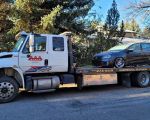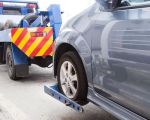How to Replace a Car's Fuel Filter: A Step-by-Step Guide
- 1 - Understanding the Fuel Filter's Role in Your Car
- 2 - Signs That Your Fuel Filter Needs Replacement
- 3 - Tools You Need to Replace the Fuel Filter
- 4 - Step-by-Step Guide to Replacing the Fuel Filter
- 5 - Troubleshooting Common Issues During Fuel Filter Replacement
- 6 - When to Call Professional Help for Fuel Filter Replacement
- 7 - Case Study: A Successful Fuel Filter Replacement
1 - Understanding the Fuel Filter's Role in Your Car
The fuel filter in your car plays a crucial role in maintaining the performance of your engine. Its job is to filter out debris, dirt, and other contaminants from the fuel before it reaches the engine. By preventing these impurities from entering the fuel system, the fuel filter ensures that your engine runs smoothly and efficiently. Over time, the filter can become clogged with debris, reducing fuel flow and negatively impacting your car's performance.
Understanding how the fuel filter functions is essential for recognizing when it’s time for a replacement. A clogged or dirty fuel filter can lead to poor acceleration, engine misfires, and increased fuel consumption. Replacing the fuel filter regularly as part of your car's maintenance can save you from expensive repairs and improve your vehicle's fuel efficiency.
2 - Signs That Your Fuel Filter Needs Replacement
There are several signs that can indicate a problem with your fuel filter. Being able to recognize these signs early can save you from more severe engine issues down the road. Here are a few of the most common symptoms that suggest it’s time to replace your car’s fuel filter:
- Engine Misfires: If you experience engine misfires or sputtering while accelerating, it could be a sign that the fuel filter is clogged and unable to deliver a consistent flow of fuel to the engine.
- Difficulty Starting the Engine: A blocked fuel filter can prevent fuel from reaching the engine, making it harder to start the car, especially when the engine is cold.
- Decreased Fuel Efficiency: A dirty fuel filter can restrict fuel flow, forcing the engine to work harder and consume more fuel. If you notice your fuel efficiency dropping, it may be time for a replacement.
- Engine Stalling: If the engine stalls or shuts off unexpectedly, it could indicate that the fuel filter is clogged, causing an inconsistent fuel supply.
- Unusual Sounds from the Fuel Pump: If your car’s fuel pump is working harder than usual to push fuel through a clogged filter, you may hear strange sounds coming from the fuel tank.
If you notice any of these signs, it’s a good idea to replace the fuel filter as soon as possible to avoid further damage to your car’s engine.
3 - Tools You Need to Replace the Fuel Filter
Replacing a fuel filter is a relatively simple task, but having the right tools is essential for a smooth and safe replacement. Here’s a list of the basic tools you’ll need to replace the fuel filter:
- Wrenches or Socket Set: These tools will help you remove and tighten bolts and fasteners holding the fuel filter in place. A socket set with different sizes may be required depending on your car model.
- Fuel Line Disconnect Tool: Some vehicles have quick-connect fuel lines that require a special tool to disconnect the fuel lines from the filter safely.
- Drip Pan: A drip pan or container is necessary to catch any excess fuel that may spill out during the replacement process.
- Replacement Fuel Filter: Of course, you’ll need a new fuel filter that’s compatible with your vehicle. You can check your car’s manual or consult with a professional to ensure you’re purchasing the correct filter.
- Gloves and Safety Glasses: Safety is crucial when working with fuel. Wear gloves and safety glasses to protect your hands and eyes from fuel and debris.
Having these tools on hand will help make the process easier and ensure you complete the fuel filter replacement safely.
4 - Step-by-Step Guide to Replacing the Fuel Filter
Now that you understand the importance of the fuel filter and the tools required, let’s dive into the step-by-step process of replacing the fuel filter:
- Step 1: Locate the Fuel Filter: The first step is to locate the fuel filter. The location of the filter depends on the make and model of your car, but it’s usually found along the fuel line, either near the fuel tank or the engine.
- Step 2: Relieve Fuel System Pressure: Before disconnecting any fuel lines, it’s important to relieve the pressure in the fuel system to avoid fuel spray. Refer to your car’s manual to learn how to safely relieve the pressure.
- Step 3: Disconnect the Fuel Lines: Use the fuel line disconnect tool to carefully disconnect the fuel lines from the filter. Be prepared for some fuel spillage, so have your drip pan ready.
- Step 4: Remove the Old Fuel Filter: Once the fuel lines are disconnected, use your wrenches or socket set to remove any bolts or fasteners holding the old fuel filter in place. Carefully remove the old filter and dispose of it properly.
- Step 5: Install the New Fuel Filter: Position the new fuel filter in place, making sure the fuel flow direction is aligned with your car’s system. Reattach the fuel lines and tighten any bolts or fasteners securely.
- Step 6: Test for Leaks: Once everything is reconnected, start the car and check for any fuel leaks. If you notice any leaks, turn off the engine immediately and recheck your connections.
After following these steps, your new fuel filter should be in place and ready to go. Always refer to your vehicle’s manual for any specific instructions or precautions.
5 - Troubleshooting Common Issues During Fuel Filter Replacement
Sometimes, problems may arise while replacing your fuel filter. Here are some common issues you might encounter and how to address them:
- Fuel Leaks: If you notice fuel leaks after installation, make sure the fuel lines are properly connected and the filter is installed in the correct direction. Check for any damaged seals or gaskets.
- Hard-to-Remove Bolts: If the bolts holding the filter in place are rusted or stuck, use a penetrating oil to loosen them. Be patient and use the right tools to avoid damaging the parts.
- Incorrect Filter Installation: Ensure that the new filter is installed in the correct orientation. The fuel filter has a specific direction for fuel flow, which should be indicated on the filter itself.
If you encounter issues during the replacement, don’t hesitate to seek professional assistance to avoid causing damage to your car’s fuel system.
6 - When to Call Professional Help for Fuel Filter Replacement
While replacing a fuel filter is a relatively simple task for those with basic mechanical knowledge, there are times when it’s best to call in a professional. If you don’t feel comfortable working with fuel or if you encounter significant difficulties during the replacement, it’s a good idea to take your car to a mechanic.
Additionally, some vehicles have more complex fuel systems that require specialized tools or knowledge to replace the fuel filter. If you’re unsure, seeking professional help will ensure the job is done correctly and safely.
Professional mechanics at a trusted auto repair shop can replace the fuel filter quickly, saving you time and potentially costly mistakes.
7 - Case Study: A Successful Fuel Filter Replacement
Let’s take a look at John’s experience replacing his car’s fuel filter. John had noticed poor acceleration and engine misfires, signs that his fuel filter was clogged. He followed a step-by-step guide to replace the filter, using the proper tools and safety equipment. Despite a few challenges with stubborn bolts, he successfully completed the replacement in under two hours. After starting the car, he was pleased to see the engine running smoothly again, with improved acceleration and no misfires. John saved money by doing the job himself and learned valuable skills for future car maintenance.
This case highlights how simple and cost-effective fuel filter replacement can be with the right tools and approach. It’s an essential task that can keep your car running smoothly and prevent more costly repairs in the future.





























